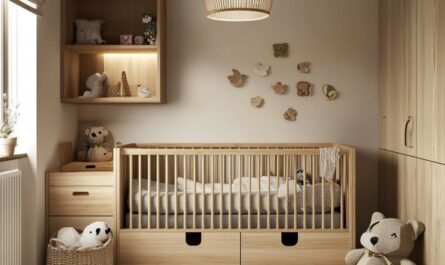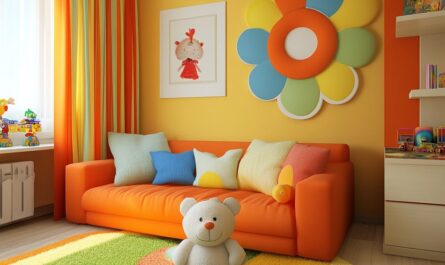Basic principles for choosing furniture for a children’s room
When choosing furniture for your child’s room, there are several key principles to consider to create a safe and comfortable space for your child. It is important that the furniture is functional, reliable and durable. Furniture should correspond to the age and needs of the child, and also fit into the interior of the room. For example, cribs with sides are suitable for a baby, and more complex storage systems with work tables are suitable for a schoolchild.
You should also consider the possibility of changing furniture as the child grows older. Many modern models can be transformed, which allows them to be adapted to changing needs. When choosing furniture, you should also pay attention to its compliance with general safety and environmental standards.
Functional areas and their arrangement
One of the most important aspects when organizing a children’s room is proper zoning of space. Each zone should be functional and appropriate for the child’s age. For a baby, it is worth highlighting a sleeping area with a comfortable crib and a place to play, and for a schoolchild, areas for study and relaxation are important. The desk should be comfortable and spacious enough to do schoolwork.
Don’t forget about the storage area. Filing systems or multifunctional cabinets will help keep your room organized. Properly organized space contributes to the development of the child and allows him to feel confident in his personal space.
Furniture safety: what to look for
The safety of children’s room furniture should be a priority. It is important that the furniture is made of high-quality materials that do not emit harmful substances. Pay attention to the stability of furniture so that it cannot tip over or fall on the child. The absence of sharp corners and protection against pinched fingers in doors and drawers will help avoid injuries.
It is also worth choosing furniture with rounded edges, and the fittings should be safe. This is especially true for furniture that will be used by small children. Protective coatings such as anti-slip feet can add additional stability to furniture.
Materials and their effect on child health
Furniture used in a children’s room must be made from materials that are safe for the child’s health. The best choice is natural materials, such as wood, with mandatory certifications confirming the absence of harmful substances. Modern finishing materials must be hypoallergenic and resistant to external influences such as moisture and dirt.
Particular attention should be paid to paints and varnishes that are used for finishing furniture. They must be non-toxic and not release harmful substances into the air. The use of such materials helps create a healthy atmosphere in the room, which is extremely important for a growing organism.
Furniture style and design: how to take into account your child’s preferences
The style and design of furniture for a children’s room should correspond to the preferences of the child himself. At first, when the child is still too small, the parents choose the style, focusing on the general atmosphere in the house and harmony with the interior. But with age, the child begins to show his own tastes and interests, and this should be taken into account when choosing furniture.
In the interior of a children’s room, you can use bright elements that stimulate the child’s creative thinking, or, conversely, calmer and neutral shades to create a relaxing atmosphere. It is important that the furniture is not only beautiful, but also comfortable for the child. Furniture should be comfortable and meet age needs.
How to choose furniture taking into account the age of the child
The choice of furniture for a children’s room depends on the age of the child, since his needs change every year. It is important that the furniture meets not only the functional requirements, but also the developmental interests of the child. The right choice of furniture can have a significant impact on his physical and psycho-emotional development. Let’s consider the main aspects of choosing furniture depending on the age of the child.
- For infants (up to 3 years): Ideal are cribs with sides that ensure the safety of the baby, and chests of drawers for easy storage of clothes. It is also worth paying attention to high chairs and soft crawling mats.
- For preschoolers (3-6 years): At this age, furniture is important that will stimulate the development of independence. Shelves and cabinets should be accessible to the child, and the bed should be spacious enough for games. A convenient solution would be chairs and tables with height adjustment.
- For younger schoolchildren (6-12 years old): A study desk and a comfortable chair are essential elements. Furniture should help maintain correct posture, and also have space for storing textbooks and office supplies. Dressers and shelves should be spacious and comfortable for independent use.
- For teenagers (12-18 years old): At this age, furniture should take into account not only functional requirements, but also the preferences of the teenager. Tables, chairs and cabinets should be stylish and comfortable. Often teenagers prefer furniture that not only fulfills its main role, but also reflects their personality.
- Universal solutions: There are furniture models that can be used in different age groups, for example, transformable beds and multifunctional wardrobes that grow with the child, adapting to his changes.
It is important that the furniture is appropriate for the child’s age and ensures comfort and safety. Taking these aspects into account, you can create a cozy and functional environment that will serve its owner for a long time, helping to develop and adapt to new stages of life.
Questions and answers
Answer 1: Furniture should be functional, safe and durable, appropriate for the age of the child and the interior of the room.
Answer 2: Zoning helps create a comfortable space for sleeping, studying and playing, improving functionality and comfort.
Answer 3: Furniture must be stable, without sharp corners and have safe fittings to avoid injury.
Answer 4: It is best to choose natural, hypoallergenic materials, such as wood, with certifications confirming their safety.
Answer 5: Style and design should take into account the child’s preferences, creating a comfortable and inspiring experience.sufficient space for its development.



